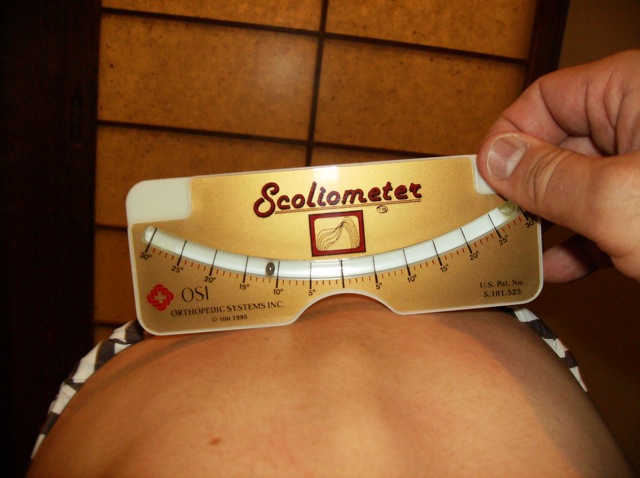
A Scoliometer™ is an instrument that measures trunk asymmetry in scoliosis, or angle of trunk rotation (ATR). It is a small, non-invasive device (essentially a mini-level) that is placed over the spine while a person is in a forward bending position. The Scoliometer™ reading indicates the degree of trunk asymmetry (rotation). Research shows that most people have a small degree of spinal rotation. However, depending on the measurement, spinal rotation is a possible indicator that scoliosis may be present. Scoliosis is officially diagnosed/confirmed with an x-ray, which is used to measure the Cobb angle (degree of the curve angle).
Frequently, patients and parents are confused between the Scoliometer™ and Cobb angle because both are reported in degrees. Often, patients will come to see us for an initial evaluation for scoliosis but have never had a Scoliometer™ measurement. This points to the necessity of spinal screenings to detect scoliosis.
The Scoliometer™ reading is a good baseline measurement. It makes it easy to monitor trunk asymmetry during follow-ups. However, like Cobb angle, this assessment is also subject to errors since the patient must assume the same position each time and there can be a variation among examiners. (See studies below). It’s most reliable when the same examiner performs the reading.
Hence, the Scoliometer™ is a good tool for scoliosis screening but should not be the only tool used for diagnosis. Scoliometers are commonly used in school screenings. Depending upon what the Scoliometer™ shows, an adolescent may then be referred for a spinal x-ray. Some practitioners will refer for an x-ray to confirm scoliosis at 5º, some at 7º. The x-ray will determine if scoliosis is present and allow the physician to measure the degree or severity of scoliosis on x-ray. When scoliosis is present the physician should report the Cobb angle of the spinal curve(s) to the patient and/or parents. It is then that a treatment plan can be determined based on the curve measurement and other factors.
At Scoliosis 3DC®, Scoliometer™ measurements are just one of the criteria we use to monitor scoliosis over time in patients who wear a scoliosis brace or who have participated in our Schroth program.

